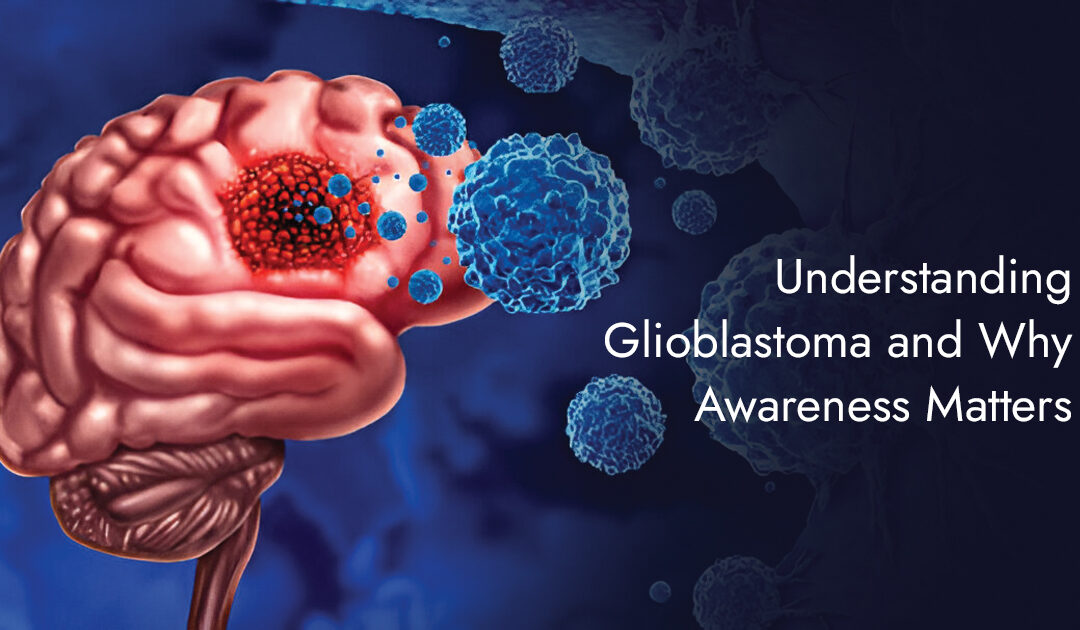Glioblastoma is a kind of cancer that originates in the brain or spinal cord. It starts with astrocytes, which are the cells that support nerve cells. Glioblastoma spreads swiftly and can harm healthy tissues. The cancer can spread to other parts of the brain as well. It is the most prevalent kind of malignant or cancerous brain tumor in adults, accounting for over 50% of all cancerous brain tumors. To save lives, it is critical to raise awareness of glioblastoma and encourage early identification. Understanding the causes, symptoms and other important information about Glioblastoma will help in efficiently raising awareness about this deadly disease. This article has been written with that purpose in mind.
What causes Glioblastoma?
The majority of glioblastomas have unknown causes.
Glioblastoma develops when cells in the brain or spinal cord undergo DNA alterations. “Mutations” or “Variants” are terms used by healthcare experts to describe these changes. Cancer cells’ DNA alterations instruct them to produce a large number of cells quickly. This large production of cancer cells produces a lump known as a tumor. The tumor may expand to push on surrounding nerves and sections of the brain or spinal cord. This causes glioblastoma symptoms, which can lead to consequences. The tumor can spread to invade and destroy healthy body tissue.
What are the symptoms of Glioblastoma to look out for?
Experts are unsure why certain people acquire dangerous brain tumors, including Glioblastoma, but some symptoms have been found. Glioblastoma symptoms appear quickly. The developing tumor puts pressure on the brain, resulting in symptoms such as:
- Double or blurred vision.
- Headaches.
- Appetite loss.
- Memory issues.
- Mood and/or personality changes.
- Muscle weakness or balance issues.
- Nausea and vomiting.
- Seizures.
- Speech difficulties.
- Changes in sensation, such as numbness or tingling.
What are the risk factors associated with Glioblastoma?
Like every disease, Glioblastoma also has some factors that can increase the risk of acquiring it. They are:
- Growing older: Glioblastomas are most common in older people. However, glioblastoma can occur at any age.
- Being exposed to ionizing radiation: People who have been exposed to ionizing radiation are at a higher risk of developing glioblastoma. Microwaves emitted by an oven are one type of ionizing radiation.
- Inherited cancer risk syndromes: In some families, DNA alterations passed down from parents to children may raise the risk of developing glioblastoma. These syndromes can be detected by genetic testing.
What are the management and treatment options for glioblastoma?
Unfortunately, Glioblastoma has no known treatment. To reduce symptoms, treatments aim to remove or shrink the tumor. The initial procedure is surgery called Craniotomy, to remove the tumor, followed by radiation and chemotherapy. If surgery is not an option owing to your health or the location of the tumor, radiation and chemotherapy can help control it.
Radiation therapy employs S-rays to destroy cancer cells and prevent them from growing. You could require up to 30 daily radiation treatments over six weeks, and chemotherapy medication circulates in your blood to kill cancer cells. Chemotherapy can be administered concurrently with radiation therapy or after it has been completed.
Some other treatments that are employed to tackle glioblastoma include:
- Intensity modulated radiation therapy (IMRT)
- Stereotactic radiosurgery
- Targeted therapy
- Tumor treatment fields (TTF)
Fighting Glioblastoma is a true battle, but with awareness, we can combat it. This aggressive brain tumor must be detected early for the best chance of successful therapy. While the specific causes are unknown, understanding the risk factors and symptoms allows people to seek medical attention as soon as possible.
Glioblastoma Awareness Day, held annually on the third Wednesday of July, serves as an important reminder. This year, let’s band together to spread knowledge. Share information about Glioblastoma with your loved ones, advocate for more research funds and donate to organizations dedicated to discovering a cure.
Raising awareness serves to aid patients, accelerate research, and eventually save lives. Let us shift the tide against glioblastoma one informed voice at a time.

